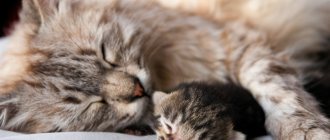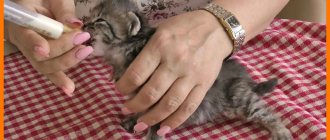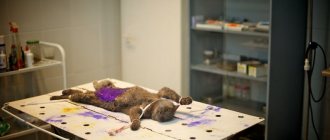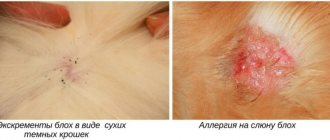Home » Useful Information
- 2 Nurse cat or artificial feeding
- 3 Preparing a place for keeping kittens
- 4 How often to feed kittens
- 5 Cow's milk or formula?
- 6 How to make your own mixtures
- 7 How to properly feed a blind kitten
- 8 How to determine if a kitten is fed enough
- 9 Simple and important care tips
In what cases are newborn blind kittens left without a mother-nurse?
In what cases does the question arise, how to feed newborn kittens without a cat?
Sometimes it happens that a cat dies during childbirth or immediately after it.
It happens that for some reason she refuses to feed her offspring.
And sometimes the soulless owners of their four-legged pet can simply throw the offspring outside so as not to violate their comfort zone.
In any case, orphaned kittens can be saved, even if it is not possible to find a nursing cat and give her sucklings.
A wet nurse is, of course, an ideal option, but such an opportunity is not always available.
Caring for newborn kittens requires patience and some knowledge
The main thing is to properly ensure their maintenance. And this:
- arrangement of a cozy “nest” with heating;
- providing nutrition equivalent to mother's milk;
- proper care for babies, taking into account their physiological needs.
What to feed a sick cat
In the advanced stage of any disease, the cat refuses to eat. There can be many reasons: loss of strength, nausea, pain during chewing, loss of smell, lack of a swallowing reflex, injury or inflammation of the throat, etc. Hunger quickly leads a cat to exhaustion, and if the pet still doesn’t drink, then to dehydration.
Feeding a sick cat requires an individual approach , since you need to clearly understand the needs of the body and adapt to them. Without permanent consequences, a cat can fast for 24 hours, but a noticeable slowdown in metabolism will occur after 12 hours.
Note! A slowdown in metabolism leads to less production of leukocytes and a decrease in the body’s cleansing function... in other words, loss of strength and progression of the disease.
Almost always carbohydrates , since, while fighting the disease, the pet loses weight. It is important not to overdo it, since the body also wastes energy not processing carbohydrates. To help your pet you need to provide him with the most comfortable conditions, warmth and eliminate the need to move around his home.
The type and method of nutrition is selected taking into account the maximum number of consequences of the disease. The minimum that needs to be taken into account is:
- Weakened intestinal microflora - almost always, if a cat has a fever, colonies of friendly bacteria die en masse. Visually this is not noticeable, but the consequences will not take long to appear - the cat will have indigestion. Conclusion - food should be easy to digest.
- Exhaustion - the body of a sick cat throws all its resources into fighting the disease, so the fur, skin, and some mucous membranes are left without the usual nutrition. Conclusion - food should be nutritious.
- Irritation of mucous membranes - in cats, the mucous membranes of the eyes, nose and mouth interact almost instantly, that is, if the eyes, throat and throat are irritated. Many pets refuse to eat simply because they have difficulty swallowing. Conclusion - food should be warm, liquid or crushed and soft.
Nurse cat or artificial feeding
When deciding how to feed a newborn kitten without a cat, you need to understand that a wet nurse is the ideal solution for both the smallest kitten and its owner.
As a rule, a nursing cat accepts one or more babies easily.
The main thing is to know that the mother and her kittens are healthy and will not infect the babies with infectious diseases, in particular ear mites .
Important! Colostrum, which a cat feeds its kittens in the first two days, is usually not enough. If your kittens are older than those she is nursing, you will need to continue feeding the babies until the nurse begins to produce enough milk.
Preparing a place for keeping kittens
Under normal conditions, the cat independently provides its babies with the optimal temperature regime.
She warms the little kittens who are with her all the time.
Considering that the physiological norm for a cat’s body temperature is 38 degrees, when arranging a place for babies, it is important to take into account that in the nest it should be a little higher.
An electric or simple heating pad is suitable for heating; an infrared heater is perfect.
You can also use plastic bottles with warm water.
Of course, the water in a simple heating pad or bottle will have to be changed frequently.
But this will not be difficult, because small kittens have to be fed several times a day.
This way it will be easy to control the temperature.
It is best to wrap the bottle in a towel or terry cloth.
It is best to cover the nest with soft, non-synthetic fabric or baby diapers, which, unlike fabric, do not need to be washed.
When choosing between a cardboard box and a basin, it is better to choose a basin: a cardboard box can get wet and absorb odors.
Therefore, keeping small kittens in a basin or plastic box will be more hygienic.
carrying bag is also suitable for this purpose .
Houses for cats will also come in handy , only later: caring for orphaned kittens up to one month of age is not entirely convenient in them.
Features of caring for orphan kittens
It is important to ensure that babies are always warm. If the kittens are shivering and their paw pads are cool, it means that the temperature conditions are not suitable for them. The box should be placed close to the radiator (but not close); if there is no battery, you can put a warm heating pad wrapped in a towel in the “nest”. The recommended temperature of the room where little orphans are kept is not lower than 24 oC.
It is important to understand that newborns have weak immunity. They must be protected as much as possible from infection and colds:
- always wash your hands before picking up a kitten;
- use only sterile feeding utensils;
- protect animals from drafts (the box should have high sides and not stand under an open window or opposite the front door).
Immediately after birth, the kitten still does not know how to empty itself. The cat helps him with this. In the absence of the mother, the person will have to take care of stimulating the digestive and excretory systems. After each feeding, you need to place the kitten on its back and stroke its belly, massage under its tail with a cotton pad moistened with warm water. After about 2-3 weeks, the kitten will be able to go to the toilet on its own (after each act of defecation or urination, it must be cleaned, since the baby still does not know how to wash itself with its tongue).
Video: how to help a kitten go to the toilet
How often to feed kittens
Month-old kittens can already feed on their own.
But until this time, they will have to pay maximum attention, because they will have to be fed both during the day and at night every two to three hours.
Animals must be handled with extreme caution
The algorithm for feeding small kittens looks like this:
- up to two weeks of age, feeding every two to three hours without a night break;
- in the third and fourth weeks - every two to three hours during the day plus one night feeding;
- from the fifth to the seventh week - every three to four hours during the day, and night feeding is canceled as the babies grow older.
Temperature and dose of milk
Depending on its size, the kitten is given approximately 2.5 milliliters of the mixture, adding half a milliliter evenly after two feedings. After three days, the baby is able to drink up to 10 milliliters of milk. The temperature of the mixture should not exceed 38-39°C. That is, the mixture should not be hot, nor should it be cold. You can check whether the formula is suitable for feeding a kitten by dropping it on your wrist. The warm mixture does not burn.
Often, when feeding, they adhere to the following regimen, depending on age: - 1 week - approximately 30 milliliters per 100 grams of weight; - at 2 weeks 35 milliliters per 100 grams of weight is given; - at 3 weeks the norm is 40 milliliters per 100 grams of weight; - from 4 weeks - ranging from 48 to 53 milliliters per 100 grams of weight.
Cow's milk or formula?
Cow's milk is not the best option for a blind kitten, since its composition is significantly different from the composition of cat's milk.
In addition, it can cause allergies in kittens, resulting in redness of the skin and paws.
The ideal solution is dry mixtures, which can be purchased at veterinary pharmacies.
The mixtures have a balanced composition, which contains all the components necessary for the growing body.
Each package of powdered cat milk replacers Katzenmilch, Royal Canin BabyMilk, Gimpet Cat-Milk, Beaphar Kitty-Milk, Hartz contains a special bottle with a nipple.
Bottles with a nipple are very convenient when feeding kittens
What you need to feed kittens
Essential items include the equipment you will use to feed your kittens. You also need to purchase what you will feed. You may need a ready-made mixture or products for its preparation.
Feeding set
Feeding newborn kittens is a difficult and very responsible process. The following devices will help in this matter:
- 20 ml syringe
- Pipette or pacifier
- Feeding bottle
- Measuring spoon
- A bowl
Feed options
What to feed newborn kittens or what to replace whole cat milk with? The best option would be a nutritional mixture, which you can purchase ready-made in the form of a dry powder or prepare the milk mass yourself.
Ready-made formulas for newborn kittens are sold at a veterinary pharmacy or pet store. The kit already includes a feeding bottle, a set of nipples and a spoon for measuring the powder. Their cost is quite high. To save a little money, you can use baby food.
Many owners prepare nutritious milk formula themselves. There are quite a lot of homemade recipes. The main ingredients are eggs and milk.
How to make your own mixtures
If it is not possible to buy ready-made mixtures, you can prepare them at home yourself.
The main thing is to follow the recipe.
- “Universal” mixture:
- 20% condensed milk diluted 1:5,
- bone meal (1 tsp per 1 liter of milk).
- Mix “Kitten”
- cow's or goat's milk – 25 g
- glucose 5% (20 ml)
- powdered milk – 5 g
- vitamin supplements - 1g.
- “Vitamin” mixture - recommended for weakened and sick kittens
- milk (100 ml)
- glucose 5% (20 ml)
- 1 yolk
- vegetable oil (1/2 teaspoon)
- Tetravit (about 0.3 ml)
- 2 teaspoons of infant formula “Nutrilon fermented milk”.
- “Egg” mixture:
- cow's milk – 200 ml,
- vegetable oil – 1 tsp. spoon,
- egg yolks – 2 pcs.,
- vitamins in drops (tetravit or trivit).
The ingredients of the mixtures must be mixed thoroughly and brought to a homogeneous mass.
Before feeding, the mixture is heated to 38 degrees.
The finished mixture should be stored in the refrigerator for no more than a day.
Feeding regimen and rules
Overfeeding is just as bad as underfeeding; in order not to make mistakes, you need to know the norms for the required quantity and frequency of food intake. Formulas and milk are calculated based on weight and age. Weight gain is considered a sign of proper feeding.
For a kitten up to two weeks old, the dose is divided into 24 hours. Gradually, the frequency of snacks decreases, and portions increase. Older pets are transferred to daytime feeding.
Recommendations for feeding kittens:
- You cannot give a kitten the same thing as an adult cat, much less a human.
- There is no need to add dry food as complementary foods.
- You cannot add vitamins to the finished mixture; there are enough of them.
- All new products should be introduced gradually and in small doses. If no pathological manifestations are found after 24 hours, the product can be given to the kitten.
- The kitten should always have access to clean water.
- You need to give food as much as the baby requires, the norms are indicated for most kittens, but there is no need to force feed or starve the kitten.
How to properly feed a blind kitten
To feed a one-week or two-week-old kitten, you need to purchase a pacifier and bottle from a veterinary pharmacy.
An ordinary medical syringe without a needle will also work.
You can use a rubber tip from a pipette, pierced with a hot needle and placed on a small vial.
It is better to feed a kitten up to one month of age from a nipple
Firstly, the sucking instinct is satisfied, and secondly, the risk of aspiration of the respiratory tract with milk or formula is reduced, which can lead to pneumonia.
Feeding from a pipette or syringe requires great care.
Since babies' immunity is still weak, any infection can be fatal.
Important! Cleanliness and sterility of nipples and bottles is an integral rule that must be strictly followed.
While the cub is eating, it is advisable to stroke its head and back and talk to it quietly.
There is no need to limit milk or formula - the suckling's face should be in milk, and the tummy should be rounded.
After feeding, it is advisable to hold the suckling upright.
When the blind kitten is full, he begins to fall asleep, and milk bubbles appear from his mouth.
He needs to wipe his face with a napkin soaked in warm water.
Many people are interested in whether it is possible to determine how much food the baby has received?
It’s possible - well-fed babies calmly fall asleep, but hungry ones get restless, crawl, and squeak.
If you give them a finger, they start sucking it.
How to feed an adult cat
Force feeding of an adult cat is carried out only as prescribed by a veterinarian. Quite often, in order not to overload the animal’s intestines, the doctor prescribes subcutaneous and intravenous infusions of nutrient solutions.
Note! For some intestinal infections, cats are kept on IV drips and completely starved for 3-5 days.
When it comes to the fact that the cat can, but does not want to eat, you need to try to provoke hunger. The main tools are:
- Smell - there is a saying: “appetite comes with eating,” but in fact, the desire or reluctance to eat something depends on the attractiveness of the smell. As a stimulant, you can use gravy from industrial feed.
- My own example - eat in front of the cat and place a bowl with treats for the cat nearby. Food should be soft. Proceed as follows: take a sandwich (or other food) in your hand, slowly bite off a piece and begin to chew slowly. Put the sandwich aside and use the same hand to scoop some cat treats onto your finger and let your pet sniff. Watch the reaction; if the cat licks its lips, you are acting correctly. If the cat begins to quickly swallow saliva, this is a sign of nausea and force feeding is inappropriate. If your cat has nausea, you can try other, neutral products or you need to switch your pet to nutrient solutions.
Any liquid, homogeneous food can be given to the cat through a syringe or piston dispenser (for children). To avoid vomiting, give food little by little, 5-7 ml at a time. Repeat feeding every 1–1.5 hours and monitor your pet’s condition. In case of vomiting or indigestion, replace food with rice water and ground, boiled rice porridge.
How to determine if a kitten is fed enough
Advice! Both overfeeding and underfeeding are dangerous for both a week-old and a two-week-old kitten. We need to find a middle ground. Underfed kittens are lethargic or restless and do not gain weight. When overfeeding, problems with stool appear.
The main indicator of overfeeding is stool
If it is liquid and yellowish in color, this means that there is slight overfeeding.
With moderate overfeeding, the stool takes on shades of green.
Constant overfeeding is the cause of gray stools.
If the stool turns white, a veterinarian should be consulted to rule out infection.











